Storage Potential of the Predatory Ladybird Cheilomenes propinqua in Relation to Temperature, Humidity, and Factitious Food
Abstract
Simple Summary
Abstract
1. Introduction
2. Materials and Methods
- Duration of storage: 3, 6, 9, and 12 days in the short-term experiment; 20, 40, 60, and 80 days in the long-term experiment; and 0 (no storage) in the controls.
- Temperature: 7, 12, 17, 22, and 27 °C in the short-term experiment; 12, 15, and 17 °C in the long-term experiment (in all of the treatments, the insects were stored in the dark). These ranges of temperatures were used because we presumed that the storage temperature at the rearing facility can be strictly controlled, whereas the transportation conditions can vary considerably. Regarding the long-term experiment, our (unpublished) pilot test demonstrated that at temperatures of 10 °C and lower C. propinqua adults are not able to feed, whereas the results of our previous study [28] suggest that feeding on some factitious food is necessary for their long-term storage. On the other hand, another earlier study [30] showed that at 20 °C (in contrast to 15 °C) C. propinqua females matured and laid eggs, suggesting that the temperature of 20 °C is too high for long-term storage.
- Humidity: in both experiments, two levels of air humidity were used, i.e., low (about 50%) and high (80–90%). The low humidity was maintained using a saturated solution of calcium nitrate, and the high humidity was maintained using saturated sucrose solution.
- Trophic regime: fed vs. starved. Frozen eggs of the Angoumois grain moth Sitotroga cerealella Oliv. glued to a piece of hard paper with 30% sugar solution were used as a factitious food. In the long-term experiment, this food was offered to all of the females, whereas in the short-term experiment, it was provided in only half of the treatments (excluding those with a temperature of 7 °C, which—as was noted above, —is too low for feeding). The food was always provided in excess, as needed (e.g., daily at 27 °C and weekly at 12 °C).
3. Results
3.1. Survival
3.2. Fecundity
3.3. Egg Hatching
3.4. Final Reproductive Potential
4. Discussion
- In rearing facilities, C. propinqua females can be successfully stored for future use in mass rearing or in the biological control of pests. Under the optimal conditions (temperatures of 15–17 °C, air humidities of 50–90%, feeding on the frozen eggs of the grain moth) females can be stored for 20 days with a rather low (about 20%) and for up to 80 days with an acceptable (not more than 50%) loss of the reproductive potential. Moreover, about 80% of beetles not only survive 80 days storage but retain relatively high viability for another 20 days. Although the fecundity of these females significantly decreases, it is still enough to eliminate an initial aphid colony which usually represents a progeny of a single foundress.
- Short-term (up to 3 days) storage or transportation (shipment) can occur at a much wider range of temperatures: from 12 to 27 °C and from 12 to 22 °C for fed and starved females, respectively. Moreover, the mortality of fed females stored for up to 12 days at temperatures of 17–27 °C was still not higher than 10%, although in the absence of food they could be stored at 12–17 °C for not more than 6 days.
- In greenhouses, C. propinqua can be successfully used for the biological control of aphids by preventing colonization (a “standing army” approach [4,5,41,42,43]). Indeed, considering the 20-day viability of adults after long storage, their biweekly releases would be enough to protect the plants without even relying on the predators’ progeny. It should, however, be noted that the application of this method would require the regular supplementation of factitious food, as is also recommended by many biocontrol practitioners [4,5,41,42,43,44,45].
- Storage for more than 10 days at temperatures of 7 °C and lower results in the 100% mortality of both starved and fed females of C. propinqua. Hence, beetles of the studied population which escape from greenhouses or rearing facilities would not survive even the mild winter of the south temperate climate zone.
Author Contributions
Funding
Institutional Review Board Statement
Informed Consent Statement
Data Availability Statement
Acknowledgments
Conflicts of Interest
References
- van Lenteren, J.C. IOBC Internet Book of Biological Control, Version 6. 2012. Available online: https://www.iobc-global.org/publications_iobc_internet_book_of_biological_control.html (accessed on 12 June 2022).
- van Lenteren, J.C.; Alomar, O.; Ravensberg, W.J.; Urbaneja, A. Biological control agents for control of pests in greenhouses. In Integrated Pest and Disease Management in Greenhouse Crops; Gullino, M.L., Albajes, R., Nicot, P.C., Eds.; Springer: Cham, Switzerland, 2020; pp. 409–439. [Google Scholar]
- van Lenteren, J.C.; Bueno, V.H.; Klapwijk, J.N. Augmentative biological control. In Biological Control: Global Impacts, Challenges and Future Directions of Pest Management; Mason, P.G., Ed.; Csiro Publishing: Clayton, Australia, 2021; pp. 90–109. [Google Scholar]
- Messelink, G.J.; Bennison, J.; Alomar, O.; Ingegno, B.L.; Tavella, L.; Shipp, L.; Palevsky, E.; Wäckers, F.L. Approaches to conserving natural enemy populations in greenhouse crops: Current methods and future prospects. BioControl 2014, 59, 377–393. [Google Scholar] [CrossRef]
- Parrella, M.P.; Lewis, E. Biological control in greenhouse and nursery production: Present status and future directions. Am. Entomol. 2017, 63, 237–250. [Google Scholar] [CrossRef]
- Rathee, M.; Ram, P. Impact of cold storage on the performance of entomophagous insects: An overview. Phytoparasitica 2018, 46, 421–449. [Google Scholar] [CrossRef]
- Hodek, I. Diapause/Dormancy. In Ecology and Behaviour of the Ladybird Beetles (Coccinellidae); Hodek, I., van Emden, H.F., Honěk, A., Eds.; Wiley-Blackwell: Chichester, UK, 2012; pp. 275–342. [Google Scholar]
- Hodek, I.; Evans, E.W. Food relationships. In Ecology and Behaviour of the Ladybird Beetles (Coccinellidae); Hodek, I., van Emden, H.F., Honěk, A., Eds.; Wiley-Blackwell: Chichester, UK, 2012; pp. 141–274. [Google Scholar]
- Nedved, O.; Honěk, A. Life history and development. In Ecology and Behaviour of the Ladybird Beetles (Coccinellidae); Hodek, I., van Emden, H.F., Honěk, A., Eds.; Wiley-Blackwell: Chichester, UK, 2012; pp. 54–109. [Google Scholar]
- Kovář, I. Family Coccinellidae Latreille, 1807. In Catalogue of Palaearctic Coleoptera; Löbl, I., Smetana, A., Eds.; Apollo Books: Stenstrup, Denmark, 2007; Volume 4, pp. 568–631. [Google Scholar]
- Abdel-Salam, A.H.; El-Serafi, H.A.; Bayoumy, M.H.; Abdel-Hady, A.A. Effect of temperature and aphid-host plant variety on performance and thermal requirements of Coccinella undecimpunctata L. and Cheilomenes propinqua isis (Mulsant). J. Plant Prot. Pathol. 2018, 9, 375–380. [Google Scholar]
- Adly, D.; Fadl, H.A.; Mousa, S.F.M. Survey and seasonal abundance of mealybug species, their parasitoids and associated predators on guava trees in Egypt. Egypt. J. Biol. Pest Control 2016, 26, 657–664. [Google Scholar]
- Atuncha, H.; Ateka, E.; Amata, R.; Mwirichia, R.; Kasina, M.; Mbevi, B.; Wakoli, E. Evaluation of predation potential of coccinellids on cassava whiteflies. J. Entomol. Nematol. 2013, 5, 84–87. [Google Scholar] [CrossRef]
- Badary, H. Ecological aspects of Sassetia spp. (Coccidae: Coccoidae: Hemiptera) and their natural enemies in Egypt. Egypt. Acad. J. Biol. Sci. A Entomol. 2011, 4, 163–174. [Google Scholar] [CrossRef]
- Bayoumy, M.H.; Michaud, J.P. Cannibalism in two subtropical lady beetles (Coleoptera: Coccinellidae) as a function of density, life stage, and food supply. J. Insect Behav. 2015, 28, 387–402. [Google Scholar] [CrossRef]
- Borkakati, R.N.; Venkatesh, M.R.; Saikia, D.K. Insect pests of Brinjal and their natural enemies. J. Entomol. Zool. Stud. 2019, 7, 932–937. [Google Scholar]
- Catling, H.D. The bionomics of the South African citrus psylla Trioza erytreae (Del Guercio) (Homoptera: Psyllidae) 4. The influence of predators. J. Entomol. Soc. S. Afr. 1970, 33, 341–348. Available online: https://hdl.handle.net/10520/AJA00128789_3140 (accessed on 1 July 2022).
- Ghanim, A.A.; Abou-El-naga, A.A.; El-Serafi, H.A.; Jabbar, A.S. Studies on the population densities of certain insect pests attacking grapevine trees and their associated predators in Mansoura district. J. Plant Prot. Pathol. 2015, 6, 1089–1104. [Google Scholar] [CrossRef][Green Version]
- Magina, F.L.; Kilambo, D.L.; Maerere, A.P.; Teri, J.M. Innovative strategies for control of coffee insect pests in Tanzania: A review. Huria J. Open Univ. Tanzan 2016, 22, 63–72. [Google Scholar]
- Mahmoud, A.K.; Yousif, N.E.; Satti, A.A. Effect of three aphid species on the life tables data of the coccinellid predator, Cheilomenes propinqua vicina (Mulsant). Environ. Nat. Resour. Int. J. 2016, 1, 49–55. [Google Scholar]
- Nordey, T.; Boni, S.B.; Agbodzavu, M.K.; Mwashimaha, R.; Mlowe, N.; Ramasamy, S.; Deletre, E. Comparison of biological methods to control Aphis fabae Scopoli (Hemiptera: Aphididae) on kalanchoe crops in East Africa. Crop Prot. 2021, 142, 105520. [Google Scholar] [CrossRef]
- Ramadan, M.M.; Hassan, M.A.; Afifi, M. Ecological studies on the Peach green aphid, Myzus persicae and its natural enemies. J. Plant Prot. Pathol. 2022, 13, 29–35. [Google Scholar] [CrossRef]
- Sæthre, M.G.; Godonou, I.; Hofsvang, T.; Tepa-Yotto, G.T.; James, B. Aphids and their natural enemies in vegetable agroecosystems in Benin. Int. J. Trop. Insect Sci. 2011, 31, 103–117. [Google Scholar] [CrossRef]
- Sæthre, M.G.; Godonou, I.; Leclercq, S.; Yoto, G.T.; James, B. Assessment of aphid ecology in vegetable systems and potential for biological control agents. Acta Hortic. 2011, 911, 227–230. [Google Scholar]
- Samways, M.J. Interrelationship between an entomogenous fungus and two ant-homopteran (Hymenoptera: Formicidae-Hemiptera: Pseudococcidae & Aphididae) mutualisms on guava trees. Bull. Entomol. Res. 1983, 73, 321–331. [Google Scholar] [CrossRef]
- Spodek, M.; Ben-Dov, Y.; Mondaca, L.; Protasov, A.; Erel, E.; Mendel, Z. The cotton mealybug, Phenacoccus solenopsis Tinsley (Hemiptera: Pseudococcidae) in Israel: Pest status, host plants and natural enemies. Phytoparasitica 2018, 46, 45–55. [Google Scholar] [CrossRef]
- Youssif, M.A.I. Coccinellid species and their insect parasitoids in pear orchards at El-Khattara district, Sharkia Governorate, Egypt. J. Entomol. Zool. Stud. 2019, 7, 780–790. [Google Scholar]
- Reznik, S.; Ovchinnikov, A.; Ovchinnikova, A.; Bezman-Moseyko, O.; Belyakova, N. Photoperiodic, thermal and trophic responses of a predatory ladybird Cheilomenes propinqua. J. Appl. Entomol. 2021, 145, 134–144. [Google Scholar] [CrossRef]
- El-Heneidy, A.H.; El-Serafy, H.A.; Mohamed, N.E.; Elbanna, E.H.E. Biological characteristics of two coccinellid predators when reared on Aphis gossypii Glover and an artificial diet under laboratory condition. J. Plant Prot. Path. 2021, 12, 575–578. [Google Scholar] [CrossRef]
- Yarpuzlu, F.; Uygun, N. Effects of different temperatures on development and fecundity of a predatory beetle, Cheilomenes propinqua (Mulsant) (Coleoptera: Coccinellidae). Türkiye Biyolojik Mücadele Dergisi 2010, 1, 97–107. [Google Scholar]
- Michaud, J.P. Coccinellids in biological control. In Ecology and Behaviour of the Ladybird Beetles (Coccinellidae); Hodek, I., van Emden, H.F., Honěk, A., Eds.; John Wiley & Sons: Chichester, UK, 2012; pp. 488–519. [Google Scholar]
- Semyanov, V.P. Rearing, Long-term Storage, and Use of Tropical Coccinellidae for Aphid Control in Greenhouses; KMK: Moscow, Russia, 2006. (In Russian) [Google Scholar]
- Awad, M.; Kalushkov, P.; Nedvědová, T.; Nedvěd, O. Fecundity and fertility of ladybird beetle Harmonia axyridis after prolonged cold storage. BioControl 2013, 58, 657–666. [Google Scholar] [CrossRef]
- Ruan, C.C.; Du, W.M.; Wang, X.M.; Zhang, J.J.; Zang, L.S. Effect of long-term cold storage on the fitness of pre-wintering Harmonia axyridis (Pallas). BioControl 2012, 57, 95–102. [Google Scholar] [CrossRef]
- Seo, M.J.; Youn, Y.N. Effective preservation methods of the Asian ladybird, Harmonia axyridis (Coleoptera: Coccinellidae), as an application strategy for the biological control of aphids. J. Asia-Pac. Entomol. 2002, 5, 209–214. [Google Scholar] [CrossRef]
- Sun, G.; Zang, L.; Wang, X.; Ruan, C.; Liu, X. Effect of long-term cold storage on fecundity of pre-wintering Harmonia axyridis (Pallas) and the fitness of its progeny. J. Environ. Entomol. 2016, 38, 286–292. [Google Scholar]
- Sun, Y.X.; Hao, Y.N.; Zhou, J.J.; Liu, C.Z.; Wang, S.S. Effects of long-term cold storage on maternal and progeny fitness of laboratory-reared Harmonia axyridis adults. BioControl 2022, 67. [Google Scholar] [CrossRef]
- Khan, A.; ul Ain, Q.; Ghafoor, A.; Riaz, A.; Suleman, N. Effect of low temperature on the storage of adult and larvae of Coccinella septempunctata (Coleoptera; Coccinellidae). Int. J. Agric. Environ. Res. 2019, 5, 274–283. [Google Scholar]
- Sakaki, S.; Jalali, M.A.; Kamali, H.; Nedvěd, O. Effect of low-temperature storage on the life history parameters and voracity of Hippodamia variegata (Coleoptera: Coccinellidae). Eur. J. Entomol. 2019, 116, 10–15. [Google Scholar] [CrossRef]
- Baskaran, R.K.M.; Suresh, K. Optimum thermal regimes for adult storage of Scymnus coccivora Ayyar (Coleoptera: Coccinellidae). J. Biol. Control 2006, 20, 135–139. [Google Scholar] [CrossRef]
- Kozlova, E.G.; Krasavina, L.P.; Orlova, G.S. Experience of biocontrol use in cucumber protection from the complex of greenhouse pests. Zashchita i Karantin Rastenii 2019, 11, 39–42. (In Russian) [Google Scholar]
- Dader, B.; Colomer, I.; Adan, A.; Medina, P.; Vinuela, E. Compatibility of early natural enemy introductions in commercial pepper and tomato greenhouses with repeated pesticide applications. Insect Sci. 2020, 27, 1111–1124. [Google Scholar] [CrossRef] [PubMed]
- Benson, C.M.; Labbe, R.M. Exploring the role of supplemental foods for improved greenhouse biological control. Ann. Entomol. Soc. Am. 2021, 114, 302–321. [Google Scholar] [CrossRef]
- Brenard, N.; Sluydts, V.; De Bruyn, L.; Leirs, H.; Moerkens, R. Food supplementation to optimize inoculative release of the predatory bug Macrolophus pygmaeus in sweet pepper. Entomol. Exp. Appl. 2018, 166, 574–582. [Google Scholar] [CrossRef]
- Brenard, N.; Sluydts, V.; Christianen, E.; Bosmans, L.; De Bruyn, L.; Moerkens, R.; Leirs, H. Biweekly supplementation with Artemia spp. cysts allows efficient population establishment by Macrolophus pygmaeus in sweet pepper. Entomol. Exp. Appl. 2019, 167, 406–414. [Google Scholar] [CrossRef]
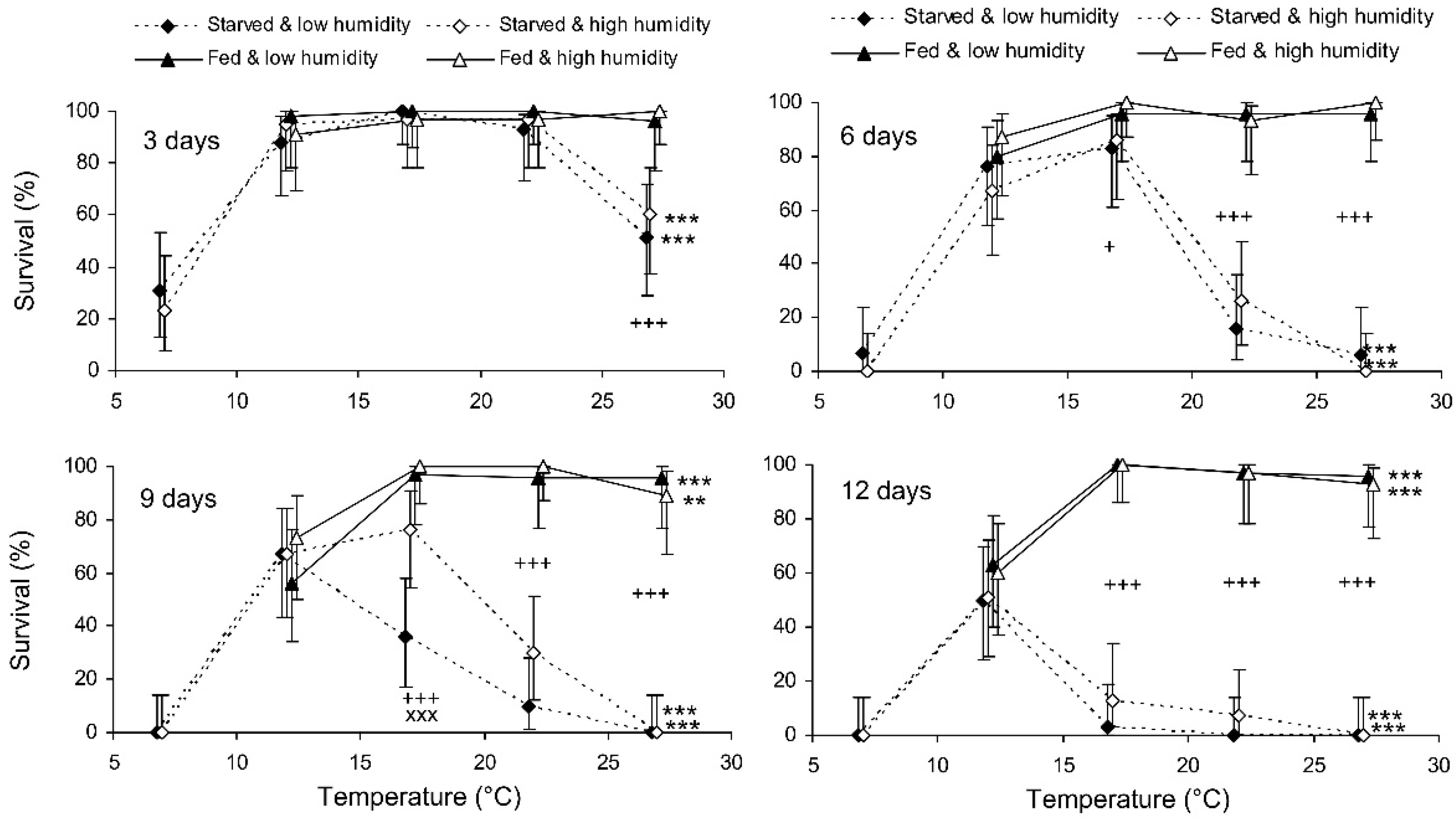
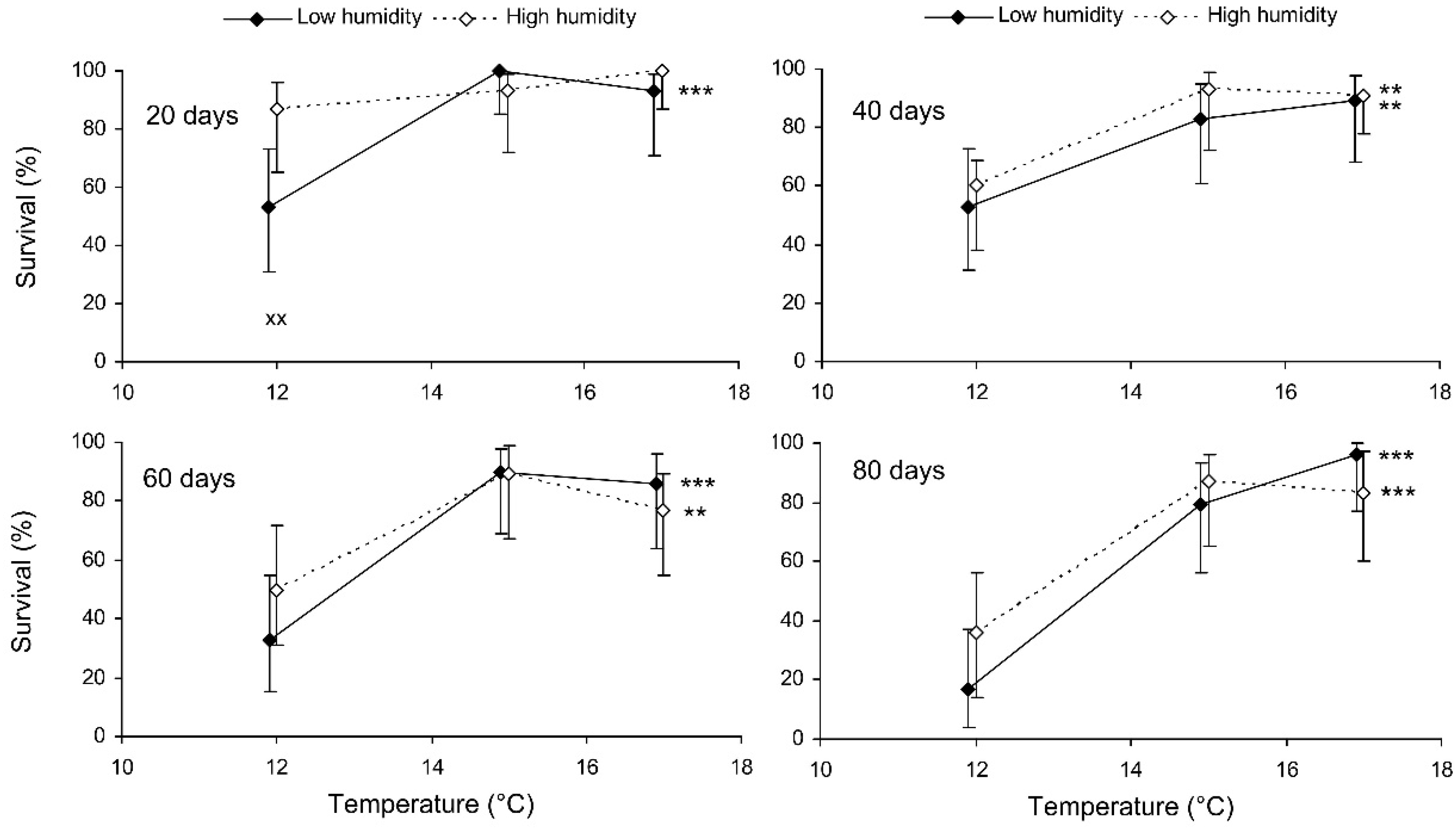
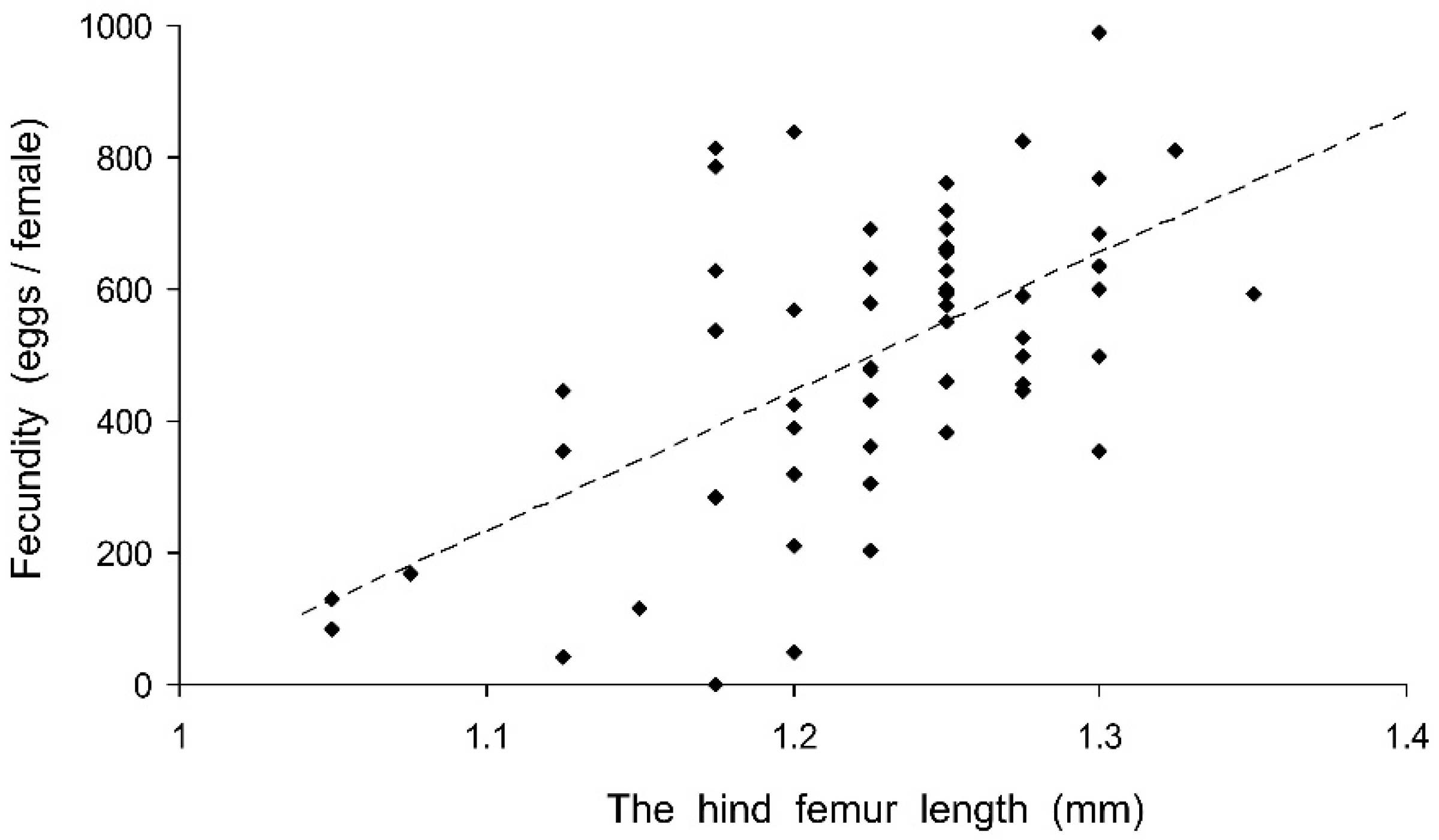
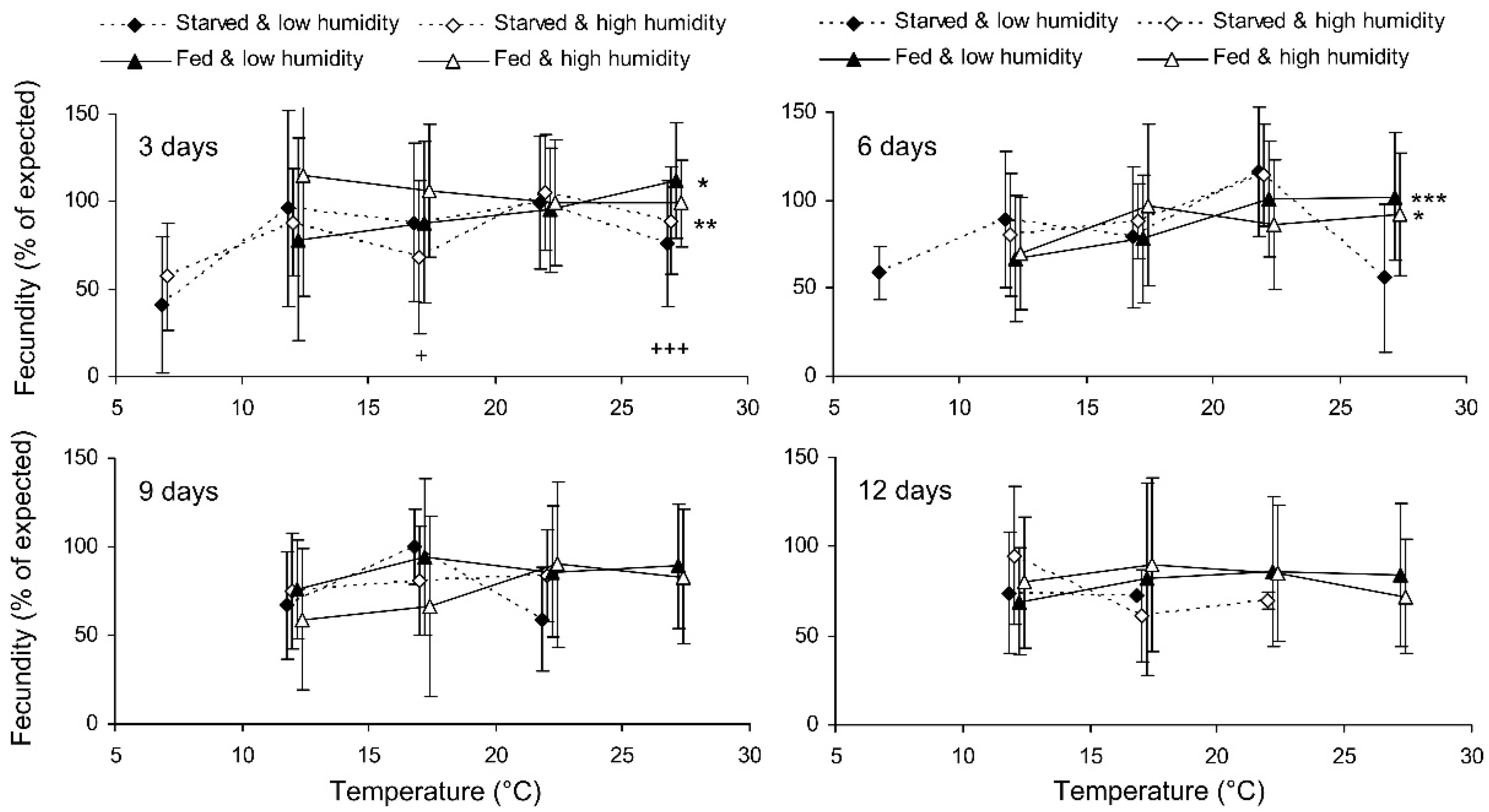
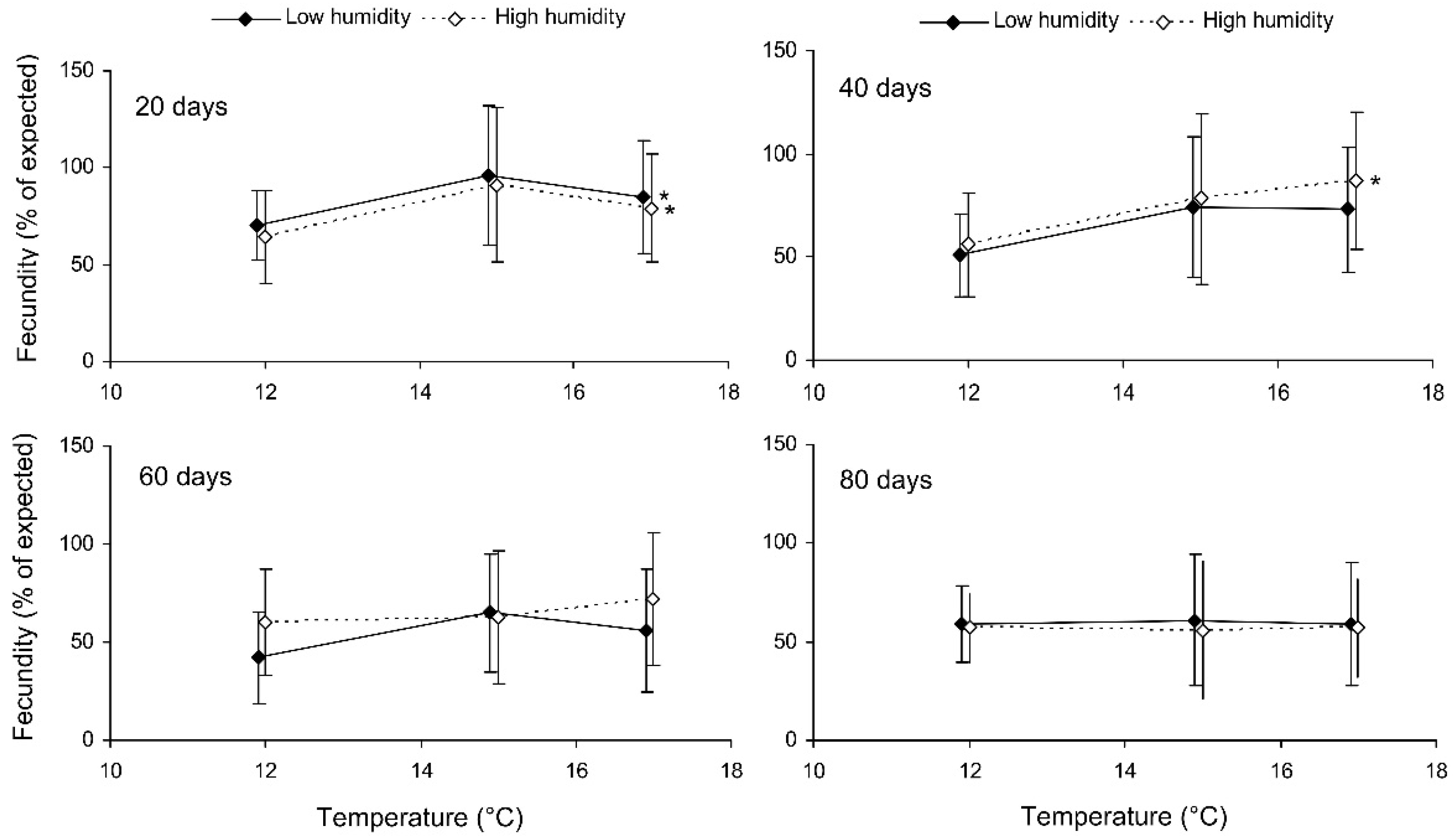
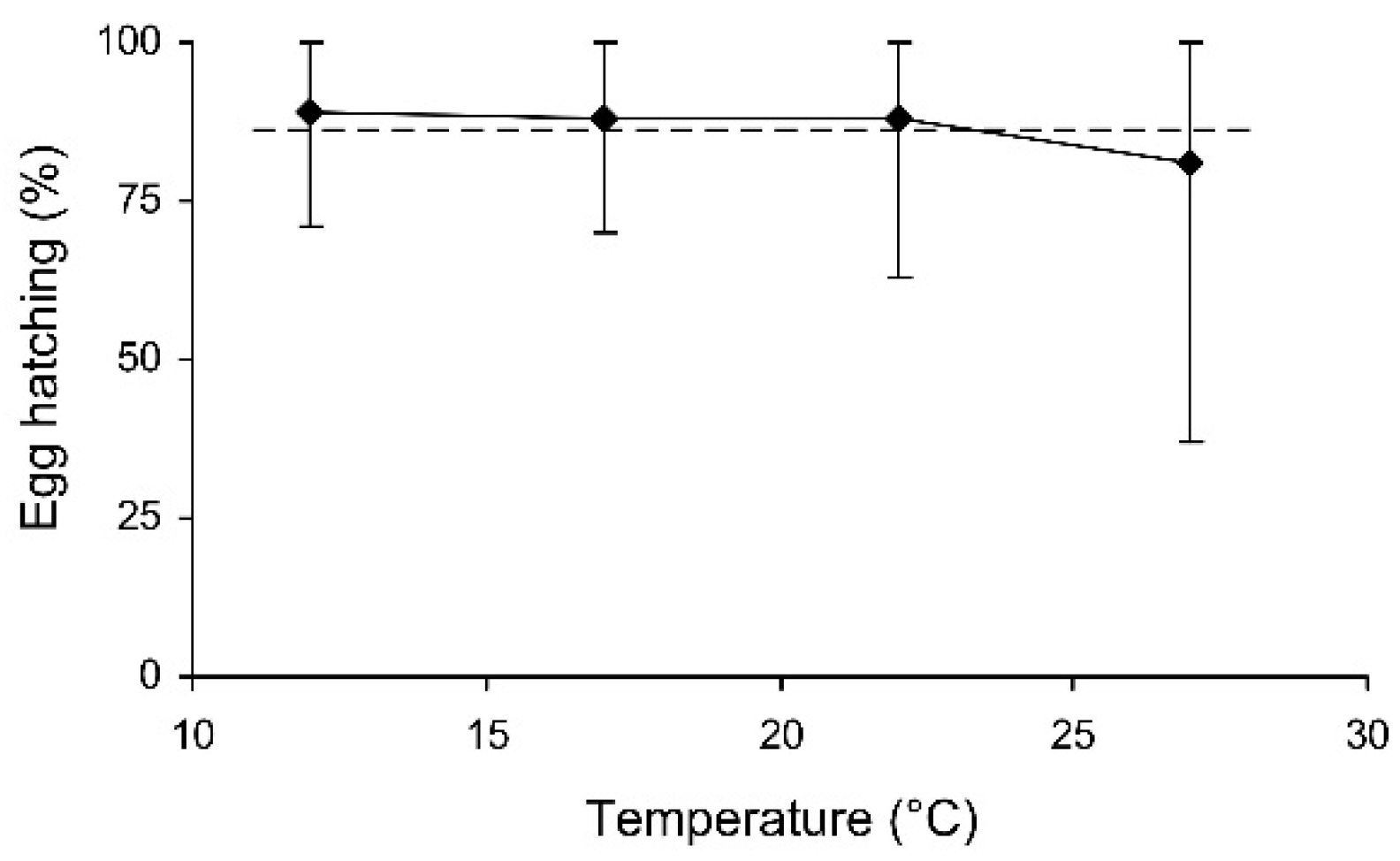
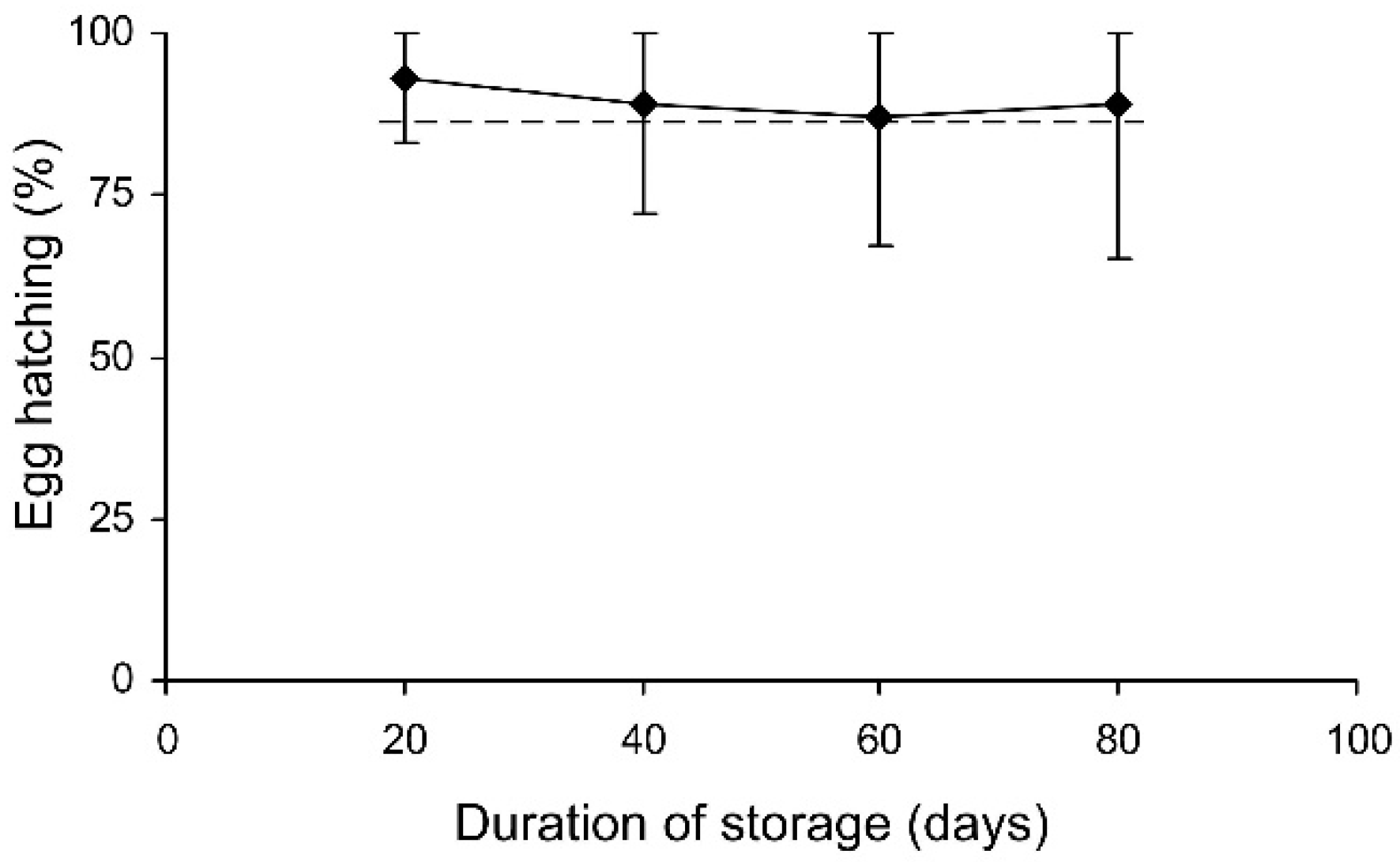
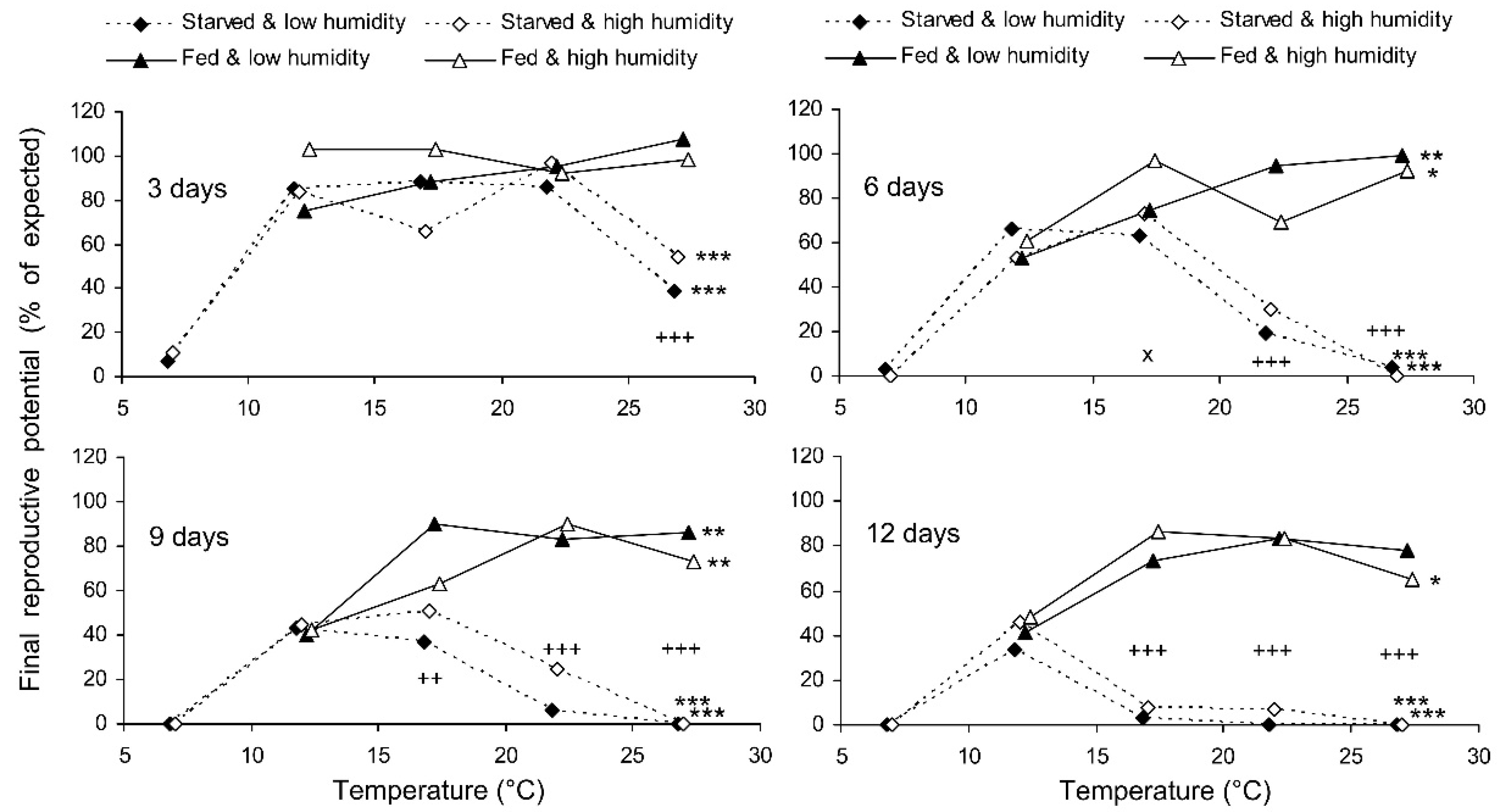
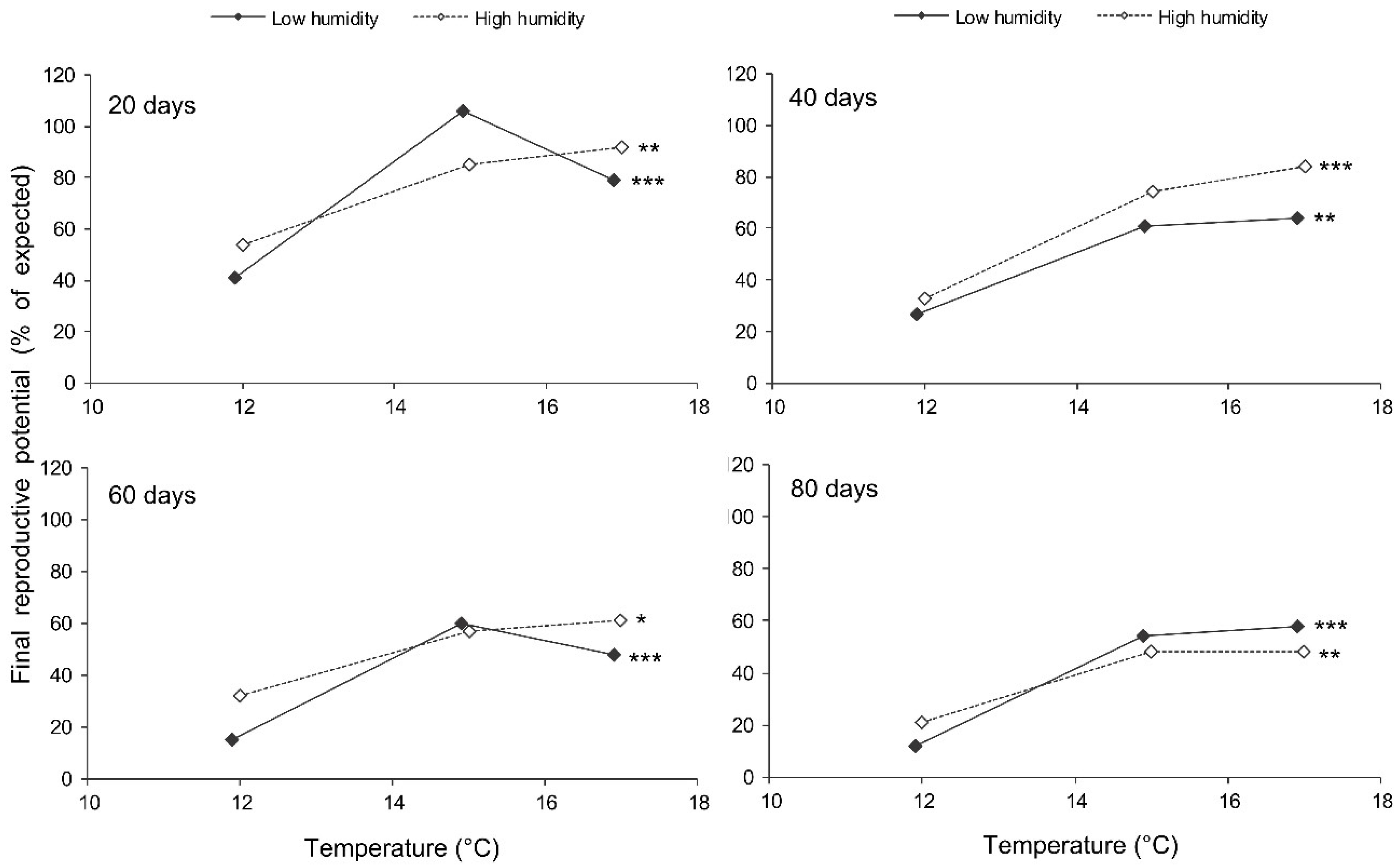
| Factor | The Short-Term Experiment (n = 1899) | The Long-Term Experiment (n = 708) |
|---|---|---|
| Trophic regime | 1.705 ± 0.079, t = 21.5, p < 0.001 | – 1 |
| Temperature | −0.048 ± 0.006, t = −7.6, p < 0.001 | 0.300 ± 0.028, t = 10.6, p < 0.001 |
| Humidity | 0.004 ± 0.002, t = 1.8, p = 0.066 | 0.006 ± 0.003, t = 1.9, p = 0.053 |
| Duration of storage | −0.173 ± 0.012, t = −14.7, p < 0.001 | −0.014 ± 0.003, t = −5.3, p < 0.001 |
| Factor | The Short-Term Experiment (n = 1285) | The Long-Term Experiment (n = 523) |
|---|---|---|
| Trophic regime | 2.944 ± 2.572, t = 1.1, p = 0.253 | – 1 |
| Temperature | 0.845 ± 0.213, t = 4.0, p < 0.001 | 3.009 ± 0.742, t = 4.1, p < 0.001 |
| Humidity | 0.006 ± 0.065, t = 0.1, p = 0.920 | 0.045 ± 0.079, t = 0.6, p = 0.567 |
| Duration of storage | −1.604 ± 0.349, t = −4.6, p < 0.001 | −0.439 ± 0.062, t = −7.1, p < 0.001 |
| Factor | The Short-Term Experiment (n = 1216) | The Long-Term Experiment (n = 495) |
|---|---|---|
| Trophic regime | −2.525 ± 2.187, t = 1.1, p = 0.249 | – 1 |
| Temperature | −0.655 ± 0.181, t = −3.6, p < 0.001 | 0.447 ± 0.730, t = 0.6, p = 0.541 |
| Humidity | −0.076 ± 0.055, t = −1.4, p = 0.167 | 0.035 ± 0.078, t = 0.5, p = 0.652 |
| Duration of storage | −0.346 ± 0.297, t = −1.2, p = 0.244 | −0.151 ± 0.062, t = −2.4, p = 0.015 |
Publisher’s Note: MDPI stays neutral with regard to jurisdictional claims in published maps and institutional affiliations. |
© 2022 by the authors. Licensee MDPI, Basel, Switzerland. This article is an open access article distributed under the terms and conditions of the Creative Commons Attribution (CC BY) license (https://creativecommons.org/licenses/by/4.0/).
Share and Cite
Reznik, S.Y.; Ovchinnikov, A.N.; Bezman-Moseyko, O.S.; Samartsev, K.G.; Belyakova, N.A. Storage Potential of the Predatory Ladybird Cheilomenes propinqua in Relation to Temperature, Humidity, and Factitious Food. Insects 2022, 13, 613. https://doi.org/10.3390/insects13070613
Reznik SY, Ovchinnikov AN, Bezman-Moseyko OS, Samartsev KG, Belyakova NA. Storage Potential of the Predatory Ladybird Cheilomenes propinqua in Relation to Temperature, Humidity, and Factitious Food. Insects. 2022; 13(7):613. https://doi.org/10.3390/insects13070613
Chicago/Turabian StyleReznik, Sergey Ya., Andrey N. Ovchinnikov, Olga S. Bezman-Moseyko, Konstantin G. Samartsev, and Natalia A. Belyakova. 2022. "Storage Potential of the Predatory Ladybird Cheilomenes propinqua in Relation to Temperature, Humidity, and Factitious Food" Insects 13, no. 7: 613. https://doi.org/10.3390/insects13070613
APA StyleReznik, S. Y., Ovchinnikov, A. N., Bezman-Moseyko, O. S., Samartsev, K. G., & Belyakova, N. A. (2022). Storage Potential of the Predatory Ladybird Cheilomenes propinqua in Relation to Temperature, Humidity, and Factitious Food. Insects, 13(7), 613. https://doi.org/10.3390/insects13070613







